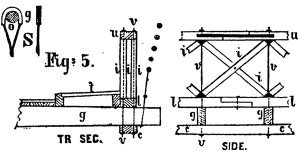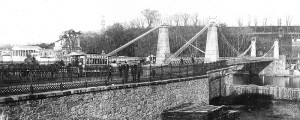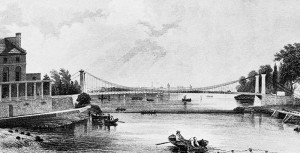In 1838, an arsonist burned Lewis Wernwag’s Colossus Bridge (STRUCTURE, June 2014) over the Schuylkill River near Philadelphia. Its 340-foot main span was, at the time, the longest single span bridge in the United States. Charles Ellet, Jr. (STRUCTURE, October 2006) immediately proposed replacing it with a wire cable suspension bridge. By this time, several Finley Chain Bridges were built in the Philadelphia area as well as a short lived, long-but-extremely-narrow, pedestrian wire bridge across the Schuylkill River built by Josiah White and Erskine Hazard.
Since it was the first wire cable bridge in the world, reference is made to an article in the Port Folio of June 1816 that indicated, “It is supported by six wires, each three eighths of an inch in diameter – three on each side of the bridge. These wires extend, forming a curve, from the garret windows of the wire factory to a tree on the opposite shore, which is braced by wires in three directions. The floor timbers are two feet long, one inch by three, suspended in a horizontal line by stirrups of No. 6 wire at the ends of the bridge and No. 9 in the center, from the curved wires. The floor is eighteen inches wide, of inch board secured to the floor timbers by nails, except where the ends of two boards meet; here, in addition to the nails, the boards are kept from separating by wire ties. There is a board six inches wide, on its edge, on each side of the bridge to which the floor timbers are likewise secured by wires. Three wires stretched on each side of the bridge along the stirrups form a barrier to prevent persons from falling off. The floor is sixteen feet from the water, and four hundred feet in length.” It was only in use for a short time, until a wooden covered bridge by Lewis Wernwag replaced Finley’s bridge.
On March 16, 1839, the Commonwealth of Pennsylvania passed an Act, commonly known as the Free Bridge Act, to “authorize the erection of free bridges over the River Schuylkill at or near Philadelphia.” Commissioners were authorized to solicit designs for a bridge at Arch Street and one at Callowhill Street.
To promote his design, Ellet wrote A Popular Notice of Wire Suspension Bridges in a 12-page pamphlet on April 15, 1839 that was later reprinted (June1, 1839) in the American Railroad Journal and Mechanics Magazine. The editors noted, “It is with great pleasure that we commend to the attention of our readers the following paper on Suspension Bridges – by one of our most able and enterprising young engineers. He has the merit of having been one of the foremost in drawing the notice of the profession to this most beautiful and economical mode of structure.” Since his earlier proposals for a major multiple span suspension bridge across the Potomac River and the Wheeling Bridge across the Ohio River had limited distribution, this was the first major, broadly distributed, article on wire suspension bridges in the United States. Some of his main points were as follows:
Particular Advantages of Wire Cables.
8. There are many reasons adduced for the preference given to wire cables, over the chains of bar iron, which they have nearly superseded. It is not possible to obtain iron free from flaws, though all reasonable precaution be observed in its manufacture; and it is not always practicable to detect the flaws by the test to which each bar is subjected prior to its employment in the structure.
16. A suspension bridge across the Schuylkill would leave the channel unobstructed, as at present. It would be secure against destruction by fire, or by flood. It would be much less expensive than a wooden bridge, constructed on permanent piers, and not more expensive than the lowest class of those bridges that could, with any show of propriety, be admitted. It would be not less firm than one of timber, and scarcely less durable than one of stone. As a contribution to the architecture of the city, and an ornament to the Schuylkill, it would be unsurpassed.
17. The lightness, grace beauty of these structures, when tastefully designed and judiciously applied, can be only adequately appreciated when witnessed in place. No drawing or description can properly represent their appearance.
And the edifice never parts with its beauty. The form it assumes, when first thrown over the stream, is the result of natural laws which are always in action, and will preserve its position and figure forever. It may at times undergo a slight inflection – imperceptible to the eye – when heavily and unequally loaded, but immediately recovers its position on the removal of the charge.
This small pamphlet was the first to describe the wire cable suspension bridge in the United States, even though Finley’s chain bridges (STRUCTURE, March 2016) were well known through his article in the Port Folio both in America and Europe and had been mentioned in Thomas Pope’s 1811 Treatise on Bridges. He then presented two sketches, one for a bridge on Arch Street with masonry side arches and one with the towers on the Wernwag abutments with the anchorage on the west, 275 feet back from the tower, and on the east two options for cable anchorage. One had the cable anchored close to the tower and one with the cable extending back to a rock cliff for anchorage.
He wrote that his drawing of the bridge appeared to some “more like cobweb or gossamer than the rough stuff adapted to the wear and tear of heavy teams and droves of beef cattle, it met with no little opposition both from well meaning and from interested parties.” He then wrote another promotional five-page piece entitled, Suspension Bridges. – Plan of the Wire Suspension Bridge About to be Constructed Across the Schuylkill, at Philadelphia for the American Railroad Journal in their March 1, 1840 issue. He wrote, in part,
The wire suspension bridge represented in the annexed engraving, was designed in compliance with an invitation of the Commissioners of the city and county of Philadelphia; and is intended to succeed the Fairmount bridge, which was destroyed by fire in the summer of 1838. The plan as approved by the Board, who have since advertised for proposals for the erection of the work; and it is understood to be their intention to urge its immediate completion.
Without adverting to the merits of this plan, as a particular application of the principle of suspension; the fact that such a bridge is about to be constructed, cannot but be matter of interest to the profession, as an auspice of the introduction into this country of an improvement which has deserved and acquired the most abundant success abroad.
The engraving of the bridge intended to be constructed across the Schuylkill offers a very faint idea of the appearance presented by such a structure, when tastefully designed and viewed in place. It will, however, serve to convey an impression of the general appearance of suspension bridges, to those who have not possessed the opportunity of witnessing some of the fine specimens of the art which have of late years been erected in Europe…
The proceeding remarks apply to the plan of the bridge as it was presented and approved; but since its adoption by the commissioners a change of the location has caused certain modifications to be made to adapt it to the new site.
The process of awarding the contract to build the bridge was anything but clean. Ellet was traveling in the west in parts of 1839 and 1840. The interactions between Ellet, John A. Roebling and Andrew Young (STRUCTURE, November 2008, Sayenga)were extensive and sometimes bitter. The contract was awarded to Young on May 9, 1840, using Ellet’s plan. On June 11, 1841, the decision was reversed and the contract was given to Ellet who signed it on June 17, 1841. The National Gazette wrote, “The plan for the bridge is beautiful, and as this is the first wire suspension bridge in the United States, it will be an object of great interest to the whole community. Mr. Ellet is entitled to great credit for this plan, and his execution of the work will give him higher claims to the consideration of his fellow citizens.” The North American reported on June 14, 1841, “We are gratified to learn that the Bridge at Fair-Mount is to be rebuilt immediately. Mr. Charles Ellet has contracted to do the work; at a cost not to exceed $71,000… The National Gazette says it is to be a wire suspension bridge on a beautiful plan the only one of the kind in the United States. The work will proceed at once, if possible, be finished before the first of January.” His design for a central span of 357 feet was ultimately selected from over five competing designs, and would be the second iron wire suspension bridge in the United States and the first of any major bridge.
Ellet started work in July and progress on the bridge was kept in front of the public by another article in the American Railroad Journal on November 15, 1841 that had originally been published in the United States Gazette. It wrote,
The bridge is constructed at the expense of the county, and under the superintendence of Mr. Ellet, the Engineer, who furnished the plan. We wish him success in his enterprise; though we should judge from the magnitude of the edifice, and the costliness of the materials employed, that the contract price (fifty thousand dollars) will hardly remunerate him for his exertions. The former bridge on the same site cost about one hundred and twenty thousand dollars, though the masonry was of the coarsest description, and the superstructure of wood. We can, therefore, hardly suppose that such an edifice as is now in progress, composed of massive blocks of granite, finely cut and beautifully fashioned, and which is supported by cables of an indestructible material, can be erected on the same ground for less than one half the cost of its predecessor. At any rate if Mr. Ellet succeeds in accomplishing the work at his estimate, we speak for this sort of bridge, a degree of popularity which may eventually remunerate him for the hardness of his present bargain.
John Trautwine noted in his Civil Engineering Handbook that there were 2,816 wires in the ten strands and that “every wire was separately boiled in a preparation of linseed oil, as often as was found to be necessary to give it a suitable coat of the varnish and after the cables were in place they were thoroughly saturated with the same material, an application found to be an adequate protection against oxidation.”
There were five 3-inch diameter strands on each side that laid flat on the top of the towers and then draped down towards mid span on different arcs, giving sag to span ratios of 1/12 to 1/13. This configuration of the cables was similar to that used by the Sequin Brothers in France and was called a garland system. Since Ellet had studied in France, he used their practices when he returned to the United States in 1831. The cables converged toward mid span, with the spacing at the top of the towers being 35½ feet and at mid span 29 feet. The suspenders were ¾-inch diameter and had a spacing of 4 feet. The suspenders were hung from each cable strand alternately such that, given there were five cables, the spacing of suspenders on any one cable would be 20 feet. At the lower end of the suspenders, the wires ran through an eyebolt passing through the lower chord and adjusted with nuts. The wire suspender was then wrapped back on itself and wrapped with wire. The width of platform out-to-out was 27 feet and from inside-of-curb to inside-of-curb 25 feet. There were walkways on each side with a width of 4 feet 4 inches, giving a roadway width of 16 feet 4 inches. The railings doubled as a stiffening element. There were three longitudinal truss members, as seen on the right side of the diagram, with the bottom two bracketing the cross beams, g, in the Howe truss form. The doubled vertical rods were 7/8-inch diameter and ran from the top chord to the bottom cord with threaded ends. The wooden diagonals were 4 by 5 inches and were set into iron castings. In the upper left corner, Trautwine had a detail on how Ellet connected his suspenders to the cable strands.
The North American reported on November 29, 1841, “This novel, yet beautiful structure, is going ahead rapidly, and will be ready for use early in the spring. The bridge itself will be composed of wood suspended from wire cables. Ten cables consisting of about 300 wires each are stretched from the abutments on each side of the river. They pass over the tops of massive granite columns 30 feet high… we imagine this beautiful bridge will be the first and the only one of the kind in this country. The greatest difficulty in its erection, we should judge, is securing the ends of the cables.” It was test loaded on January 1, 1842, at which time The North American reported, “On New Year’s day the new Wire Bridge was so far completed as to enable a number of persons to cross the river upon it. Mr. Ellet deserves credit of the rapidity with which he has pushed forward this work to completion.” The bridge opened in the spring of 1842 with a final cost of $53,000.
The bridge lasted until 1875, when Jacob Hays Linville and the Keystone Bridge Company built a double deck bridge around the suspension bridge without stopping traffic. As the first of its kind in the United States, it was a resounding success in promoting the further use of wire cable suspension bridges. Ellet went on to design bridges across the Niagara River and across the Ohio River at Wheeling. He also proposed many other bridges, but was unsuccessful in obtaining the contracts. Ellet died in June 1863 after his ramboat battle on the Mississippi River at Memphis during the Civil War. His main competitor in the wire cable business, John A. Roebling, built the replacement for Ellet’s bridge at Niagara. He built a major bridge at Cincinnati across the Ohio River and prepared the preliminary design for the Brooklyn Bridge that was built by his son, Washington A. Roebling.▪




